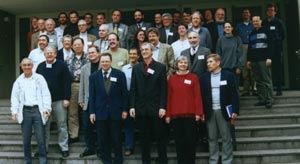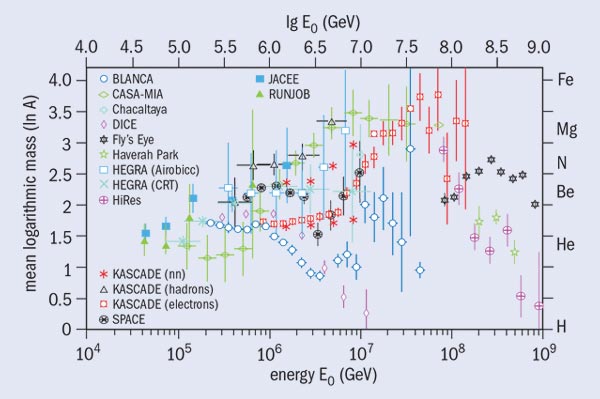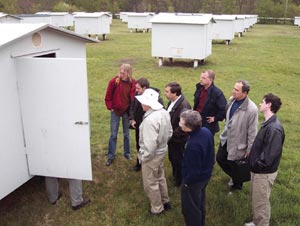Some 50 people attended the NEEDS workshop in Karlsruhe in April to discuss how accelerator experiments can help in understanding cosmic-ray data. The meeting brought together experimentalists and theorists from the accelerator and non-accelerator areas. Lawrence Jones reports.

The Karlsruhe Forschungszentrum is the home of several of the most active theorists and Monte Carlo modellers in cosmic-ray physics. It is also the site of the densely instrumented KASCADE cosmic-ray air-shower array, which has produced some of the most definitive data for energies below 100 PeV (1 PeV = 1015 eV). Karlsruhe was therefore an obvious venue for the Needs from Accelerator Experiments for the Understanding of High-Energy Extensive Air Showers (NEEDS) workshop, organized by Hans Bluemer, Andreas Haungs and Heinigerd Rebel of Karlsruhe, and Lawrence Jones of the University of Michigan.
Physicists generally understand that cosmic rays with energies up to about 1 PeV are produced by shock acceleration in supernovae. At energies up to around 1014 eV, their composition is similar to that of stars, with minor and well understood differences – for example additional lithium, beryllium and boron from spallation of carbon nuclei on interstellar nuclei. The differential spectrum falls steeply with energy as about E-27. At higher energies, however, it is unclear what the acceleration mechanism is – it is difficult to provide the required energy from supernovae shocks. Furthermore, there are indications that the composition changes, with heavier primaries becoming relatively more abundant. There is also a change in the slope of the spectrum, steepening to about E-3 at about 3 PeV. This corresponds to the momentum range where particles may escape confinement in the microgauss-level galactic magnetic fields.
Astrophysicists are interested in learning about the sources, composition and energy spectrum of the cosmic rays extending to energies above 1020 eV. Below about 1014 eV, the spectrum and composition are well known from direct observation with sophisticated detectors flown on balloons and earth satellites. However, at energies above 1 PeV, the flux is only about 100 particles per square metre per steradian per year – too low for useful direct observation. Consequently, everything we know at such energies is based on ground-level observations of air showers of electrons and photons with coincident hadrons and muons. Properties such as their densities, radial distributions, energy distributions and dependence on depth in the atmosphere can be interpreted in terms of the primary cosmic-ray energies and nuclear mass numbers.

Such interpretations of ground-level observations are heavily dependent on Monte Carlo simulations of the primary interaction in the upper atmosphere and the evolution of the resulting particle cascade. The cascade is dominated by lower-energy phenomena that are reasonably well understood. However, the primary and early subsequent interactions involve energies up through the PeV range, and existing Monte Carlos are almost entirely based upon data from fixed-target accelerator experiments below 1 TeV. A sense of the confusion that currently exists is clear on a plot showing the average of the logarithm of the nuclear mass number of the primary cosmic rays versus energy (figure 1).
Small angle measurements
Fermilab’s Tevatron Collider provides proton-antiproton collisions at a centre of mass energy approaching 2 TeV, equivalent to a cosmic ray of about 2 PeV incident on a stationary proton. Brookhaven’s Relativistic Heavy Ion Collider (RHIC) provides energies of more than 100 GeV per nucleon in beam-beam collisions of nuclei. For example, a nitrogen-nitrogen collision at RHIC is equivalent to a 5 ¥ 1014 eV cosmic-ray nitrogen nucleus incident on an air nucleus. CERN’s Large Hadron Collider (LHC), with collisions of 14 TeV in the centre of mass, will provide energies equivalent to a proton of about 1017 eV incident on a stationary proton. The LHC will also produce nucleus-nucleus collisions.

The current generation of colliders plus the LHC will, in principle, be able to provide the data for the refinement of Monte Carlo models to provide a less ambiguous interpretation of cosmic-ray air-shower data. However, most accelerator studies are made with detectors that do not cover angles within one or two degrees of the beamline. Since it is within such small angles that most of the final-state energy flow occurs, this is the region that dominates air-shower observables. About 80% of the final-state energy flow in the Tevatron, for example, is estimated to be within a 28 mrad cone centred on the beam. For the LHC, this figure is 95%.
If a 2 PeV primary proton collides with an air nucleus and continues with half its initial energy, acquiring 200 MeV/c transverse momentum in the collision, it makes an angle of only 0.2 µrad with its initial direction. The equivalent Tevatron process is a TeV proton colliding with an antiproton and scattering at an angle of 0.4 mrad, well within the cone that is unobserved by detectors. This is a typical final state of interest in the calculation of air-shower development, and it is here that measurements are needed. The average value and distribution of inelasticity (1 minus the fraction of the incident energy carried by the most energetic final state hadron) in a nucleon-nucleon collision and its distribution are also quite uncertain, and vary among current Monte Carlo models. A highly inelastic interaction of a high-energy cosmic-ray proton could produce ground-level observables indistinguishable from those from a low-inelasticity first interaction of a heavier primary nucleus of the same energy.
The Karlsruhe group has developed CORSIKA, an elegant Monte Carlo code for simulating air showers. One input to this code is the physics of the first interaction of the primary cosmic ray with an air nucleus, and several codes have been developed for that simulation. It is here that the problems arise.

Markus Risse, Gerd Schatz and Andreas Haungs from Karlsruhe, and Johannes Knapp and Markus Roth from Leeds, among others, discussed results from KASCADE, from air-shower and emulsion experiments at mountain elevations, and from other observations, citing their comparisons with various Monte Carlo models. In general, none of the models fit the data as well as could be hoped for. It was encouraging, however, to learn that the models have been tuned recently to improve their agreement with data. Eugene Loh of Utah discussed events of over 1020 eV, the highest energy observed, with the Fly’s Eye technique, and Oscar Saavedra of Turin discussed unusual cosmic-ray events observed at 5200 m on Bolivia’s Mount Chacaltaya.
The status of Monte Carlo models and their varying degrees of success in simulating observations was discussed by Dieter Heck and Sergej Ostapchenko of Karlsruhe, Ralph Engel and Todor Stanev of the University of Delaware, Hannes Jung of Lund, Jean-Noel Capdevielle of the College de France, and Giuseppe Battistoni of Milan. Following these discussions, the accelerator experiments relevant to these questions were described. Speakers included Andrei Rostovtsev and Martin Erdmann of DESY, Damian Bucher and Johannes Ranft who discussed Brookhaven’s RHIC, Valeria Tano of Fermilab, and Stefan Tapprogge and Aris Angelis who discussed projects in preparation for the LHC. Lower-energy fixed-target experiments at the three laboratories, with beams of 5-120 GeV, were also discussed. Kai Zuber and Giles Barr presented the CERN’s HARP experiment. Brett Fadem of Iowa State University discussed Brookhaven’s E941, and Carl Rosenfeld of the University of South Carolina presented Fermilab’s main injector particle production (MIPP) experiment, all of which measure particle production cross-sections that are valuable for high-energy cosmic-ray work.
Priority list
A primary objective of the workshop was to develop a priority list of desired accelerator measurements that could be used to reconstruct cosmic-ray interactions in Monte Carlo models much more accurately than is currently possible. These would significantly improve the interpretation of cosmic-ray observations. The highest priority is to obtain inclusive final state spectra for protons, neutrons, charged pions, neutral pions and charged kaons from proton-proton (or proton-antiproton) interactions over the range 0.1 < I>x < 1.0, where I>x is the ratio of the longitudinal momentum of the final-state hadron to its kinematic maximum. These data would be desirable over the energy ranges spanned by RHIC, the Tevatron and the LHC. Similar data from RHIC and the LHC would be desirable from proton-nitrogen collisions, representing proton collisions with air nuclei. Inclusive final-state data from nucleus-nucleus collisions would also be useful. The primary cosmic rays of interest range up to iron, so data from iron-nitrogen collisions would be very interesting. Total cross-sections and total inelastic cross-sections for proton-proton, proton-nucleus and nucleus-nucleus collisions are highly desired, particularly for nitrogen. Pion-proton and pion-nucleus inclusive final state data would be useful, although such measurements are limited to fixed-target sub-TeV energies for the foreseeable future. The lower-energy data from the HARP, MIPP and E491 experiments will also be valuable for tuning CORSIKA and other Monte Carlos that model the atmospheric cascade.
Loh’s contribution to the priority list concerns the use of the Earth’s atmosphere as a calorimeter. The air scintillation technique used in the Fly’s Eye detectors is quite well understood, but the fraction of the total energy of the incident cosmic ray that does not appear as ionization is based on educated guesswork. It would be very useful to know better what fraction of the total incident energy is invisible to the air scintillation observations, taking the form of neutrinos, high-energy muons that lose most of their energy in the earth and nuclear binding energy, for example.
The final item on the list came from the Karlsruhe group, who would like to see spectra dependent on centrality (how close to head-on the collisions are). Such data would make microscopic knowledge of interaction mechanisms possible, rather than the currently available data averaged over all impact parameters.
Although not on this accelerator priority list, Saavedra, Jones and others noted the desirability of locating an air-shower detector array with the complexity and sophistication of KASCADE at high mountain elevations.
The workshop concluded that two elements are of primary importance; stronger links between the accelerator and cosmic-ray high-energy communities, and commitment on the part of cosmic-ray physicists to contribute actively to accelerator experiments.
Those who took part in the NEEDS workshop believe that they have taken a step towards realizing these goals.





